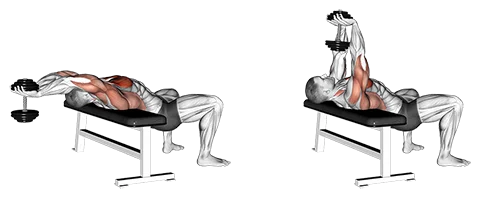Introduction
The Dumbbell Pullover is a strength training exercise that targets the chest, back, and shoulder muscles. It primarily strengthens the pectoralis major, latissimus dorsi, and deltoids, improving posture and overall upper body strength. This exercise is particularly effective for individuals seeking to build muscle mass in their upper body and improve their range of motion, making it a valuable addition to fitness routines focused on athletic performance or aesthetic goals.
Muscles Worked
- Primary: Chest (pec major) and Shoulders (deltoids)
- Secondary: Back (latissimus dorsi), Triceps, Abs
How to Do It (Step-by-Step)
- Lie on a flat bench holding a dumbbell with both hands above your head and arms fully extended.
- Lower the dumbbell slowly behind your head while keeping your arms straight and back arched slightly off the bench.
- Ensure that you do not lower the dumbbell too far, maintaining control throughout the movement, and keep your core engaged to prevent unnecessary strain on your lower back.
Tip: When bringing the dumbbell back overhead, avoid locking out your arms completely to minimize stress on your shoulder joints.
Rep & Rest Guidelines
- Strength: 4–6 reps, 2–3 min rest
- Hypertrophy: 8–12 reps, 60–90 sec rest
- Endurance: 12–20 reps, 30–60 sec rest
Use Auto Progression to automatically increase the weight as you improve.
Rest Timer ensures consistent and effective breaks between sets.
Form Tips
- Maintain a flat back: Keep your lower back pressed against the ground throughout the exercise to avoid injury and ensure proper form.
- Use a controlled motion: Lower the dumbbell slowly behind your head, pause for a moment at the bottom of the movement, then bring it back up in a controlled manner.
- Engage your core: Keep your abdominal muscles tight during the entire exercise to stabilize your spine and help prevent injury.
When to Use It
- Strengthening Upper Back and Chest: The dumbbell pullover is effective for targeting the lats (lower back muscles) and the pectorals (chest muscles), contributing to better posture and increased strength in upper body pushing movements.
- Enhancing Shoulder Flexibility: This exercise helps improve shoulder flexibility, reducing the risk of injury in activities like swimming or weightlifting by stretching the chest, shoulders, and anterior deltoids.
- Building Core Strength: The dumbbell pullover requires engagement of the core muscles to stabilize the body during the movement, thereby promoting a stronger midsection and improved functional fitness.
Workout History can help you track your progress over time and plan effective workouts based on your performance data.
The dumbbell pullover primarily targets the chest, specifically the lower pecs. It also works the shoulders and back, particularly the lats.
Aim for 3-4 sets of 8-12 reps per set to build muscle strength. If you're focusing on endurance, try 2-3 sets of 15-20 reps.
Choose a weight that allows you to comfortably complete the recommended number of sets and reps while maintaining proper form. Adjust as needed.
Lie on a bench, grasp the dumbbell with both hands, and extend your arms above your head. Lower the weight behind your head while keeping it close to your body, then return to the starting position.
While it's possible to do a standing dumbbell pullover, performing this exercise on a bench allows for better range of motion and targeting of the intended muscles.

